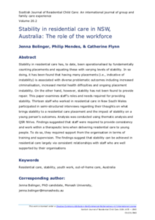Stability in residential care has, to date, been operationalised by fundamentally counting placements and equating these with varying levels of stability. In so doing, it has been found that having many placements (i.e., indicative of instability) is associated with diverse problematic outcomes including increased criminalisation, increased mental health difficulties and ongoing placement instability. On the other hand, however, stability has not been found to provide repair. This paper examines staff’s roles and needs required for providing stability. Thirteen staff who worked in residential care in New South Wales participated in semi-structured interviews regarding their thoughts on what brings stability to a residential care placement and the impact of stability on a young person’s outcomes.
Analysis was conducted using thematic analysis and QSR NVivo. Findings suggested that staff were required to provide consistency and work within a therapeutic lens when delivering residential care to young people. To do so, they required support from the organisation in terms of training and supervision. The findings suggest that stability can be achieved in residential care largely via consistent relationships with staff who are well supported by their organisations.

